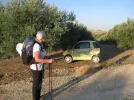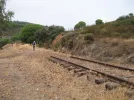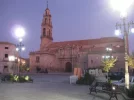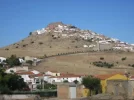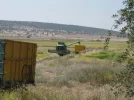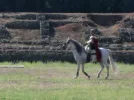Wombat
Member
Report on the Camino Mozárabe from Granada to Mérida
12 September to 8 November 2011
Part 1
Introduction
In the autumn of 2009 my wife and I completed the Camino Frances from St Jean Pied de Port to Santiago de Compostella and Finesterra. That camino was a great experience and we decided to try the route from Granada along the Camino Mozárabe to Mérida, then the Via de la Plata to Salamanca and Zamora and the Camino Sanabrés to Ourense and Santiago de Compostella.
We are both members of the Confraternity of Saint James (London) and the newly formed Australian Friends of the Camino.
I will be adding to these posts and I hope that they will be of interest to forum members. This camino was in the autumn and the average maximum temperature for Granada in September is 28.8°C. In 2011 we experienced temperatures in the low to mid 30's for most of the Camino Mozárabe. I would not want to walk in hotter temperatures. Carrying enough water and lack of shade become problems.
Guides
As guide books we used the Confraternity of Saint James (CSJ) guide “2B Granada to Mérida”, 2009 edition, for the Camino Mozárabe and Alison Raju's Cicerine “Guide to the Via de la Plata”, 2005 edition and the CSJ guide 2A Seville to Santiago, 2011 edition, for the Via de la Plata and Camino Sanabrés. In addition we gathered quite a lot of up to date information from the Camino de Santiago forum.
Maps
I find guide books quite hard to follow when walking and much prefer a map. Therefore I downloaded 1:50,000 scale maps from the Centro Nacional de Información Geográfica at http://centrodedescargas.cnig.es/Centro ... /inicio.do The downloads are free for non comercial use I then used the graphical/photo editing program GIMP to mark the camino path as best I could identify it on the maps. Then I cut strip maps from the originals (still on the computer) and printed them out. The 1200km of map fitted onto about 40 sheets of A4 paper, printed back to back. I also carried backup digital copies on an iPod Touch.
Travel to Spain
We left Adelaide, South Australia on Friday 9 September 2011, flying with Singapore Airlines to Singapore and then on to Barcelona, Spain, arriving at Barcelona El Prat airport just after 8am on 10 September. That’s about 20 hours of flying. After spending the day in Barcelona we caught the Tren Hotel (sleeper train) at from Barcelona-Santes railway station at 09.30pm for Granada. We arrived in Granada on time, about 08.30am, after a good trip and a welcome sleep.
Granada
We had breakfast at the Granada railway station and then set out to find our hostal which we had booked over the internet. The Pension San Joaquin, Calle Mano de Hierro 14-16, is comprised of two 18th century, three story buildings with a central patio decorated with glazed tiles. It is located close to the church of San Juan de Dios and near the Cathedral. Our room was a double, air conditioned with ensuite toilets and bathroom for 30€ a night. Wifi is also available. It was old but comfortable although the air conditioning barely had any effect on the temperature.
We spent two nights in Granada. On the first day, Sunday, we visited the Alhambra, one of our reasons for starting in Granada. The Alhambra is a “must visit” place if you are ever in Granada. The standard cost is 13€ per person. Its well within walking distance from Pension San Joaquin, for a pilgrim. In fact we walked everywhere in Granada. The whole of Granada is very tourist orientated but I was surprised to see boomerangs with Australian aboriginal designs and “Granada” printed on them as tourist souvenirs.
The next day we went out to the Real Monasterio de las Madres Comendadoras de Santiago to get sellos in our credencials at the start of the Camino Mozárabe. TheCSJ Guide says to ask for the sello “on the corner of the Calle Santiago and the Calle Comendadoras de Santiago”. However, the gates and door were locked with no bell. There is however, another door further along Calle Santiago with the street number “20” which opened into a vestibule with a door bell. We eventually got a nun to answer the door and she willingly stamped out credencials.
The route out of Granada is waymarked from the Monasterio in the Calle Comendadoras de Santiago.
More soon,
Kevin
12 September to 8 November 2011
Part 1
Introduction
In the autumn of 2009 my wife and I completed the Camino Frances from St Jean Pied de Port to Santiago de Compostella and Finesterra. That camino was a great experience and we decided to try the route from Granada along the Camino Mozárabe to Mérida, then the Via de la Plata to Salamanca and Zamora and the Camino Sanabrés to Ourense and Santiago de Compostella.
We are both members of the Confraternity of Saint James (London) and the newly formed Australian Friends of the Camino.
I will be adding to these posts and I hope that they will be of interest to forum members. This camino was in the autumn and the average maximum temperature for Granada in September is 28.8°C. In 2011 we experienced temperatures in the low to mid 30's for most of the Camino Mozárabe. I would not want to walk in hotter temperatures. Carrying enough water and lack of shade become problems.
Guides
As guide books we used the Confraternity of Saint James (CSJ) guide “2B Granada to Mérida”, 2009 edition, for the Camino Mozárabe and Alison Raju's Cicerine “Guide to the Via de la Plata”, 2005 edition and the CSJ guide 2A Seville to Santiago, 2011 edition, for the Via de la Plata and Camino Sanabrés. In addition we gathered quite a lot of up to date information from the Camino de Santiago forum.
Maps
I find guide books quite hard to follow when walking and much prefer a map. Therefore I downloaded 1:50,000 scale maps from the Centro Nacional de Información Geográfica at http://centrodedescargas.cnig.es/Centro ... /inicio.do The downloads are free for non comercial use I then used the graphical/photo editing program GIMP to mark the camino path as best I could identify it on the maps. Then I cut strip maps from the originals (still on the computer) and printed them out. The 1200km of map fitted onto about 40 sheets of A4 paper, printed back to back. I also carried backup digital copies on an iPod Touch.
Travel to Spain
We left Adelaide, South Australia on Friday 9 September 2011, flying with Singapore Airlines to Singapore and then on to Barcelona, Spain, arriving at Barcelona El Prat airport just after 8am on 10 September. That’s about 20 hours of flying. After spending the day in Barcelona we caught the Tren Hotel (sleeper train) at from Barcelona-Santes railway station at 09.30pm for Granada. We arrived in Granada on time, about 08.30am, after a good trip and a welcome sleep.
Granada
We had breakfast at the Granada railway station and then set out to find our hostal which we had booked over the internet. The Pension San Joaquin, Calle Mano de Hierro 14-16, is comprised of two 18th century, three story buildings with a central patio decorated with glazed tiles. It is located close to the church of San Juan de Dios and near the Cathedral. Our room was a double, air conditioned with ensuite toilets and bathroom for 30€ a night. Wifi is also available. It was old but comfortable although the air conditioning barely had any effect on the temperature.
We spent two nights in Granada. On the first day, Sunday, we visited the Alhambra, one of our reasons for starting in Granada. The Alhambra is a “must visit” place if you are ever in Granada. The standard cost is 13€ per person. Its well within walking distance from Pension San Joaquin, for a pilgrim. In fact we walked everywhere in Granada. The whole of Granada is very tourist orientated but I was surprised to see boomerangs with Australian aboriginal designs and “Granada” printed on them as tourist souvenirs.
The next day we went out to the Real Monasterio de las Madres Comendadoras de Santiago to get sellos in our credencials at the start of the Camino Mozárabe. TheCSJ Guide says to ask for the sello “on the corner of the Calle Santiago and the Calle Comendadoras de Santiago”. However, the gates and door were locked with no bell. There is however, another door further along Calle Santiago with the street number “20” which opened into a vestibule with a door bell. We eventually got a nun to answer the door and she willingly stamped out credencials.
The route out of Granada is waymarked from the Monasterio in the Calle Comendadoras de Santiago.
More soon,
Kevin






